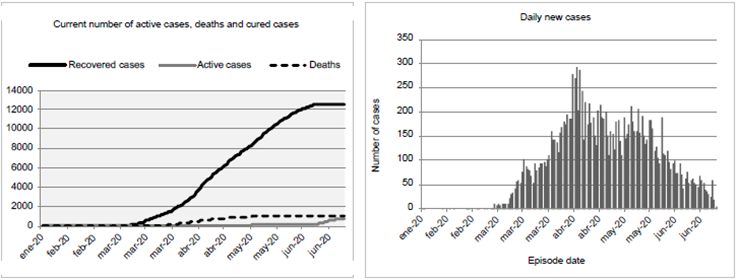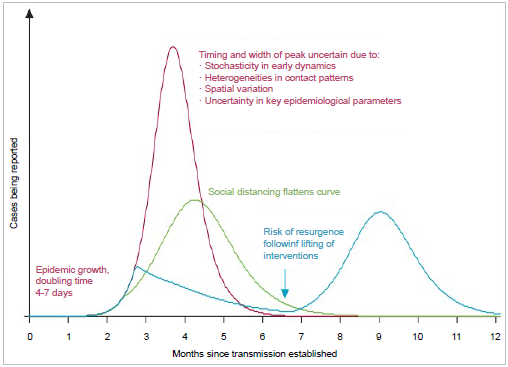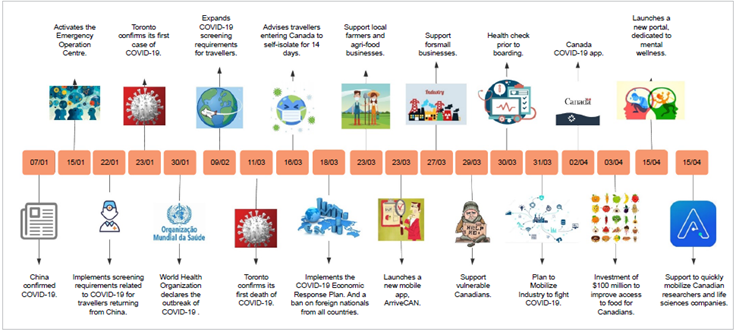The severe acute respiratory syndrome coronavirus 2 (SARS-COV-2) is the agent known to cause the coronavirus disease (COVID-19), a pandemic declared in March 2020 1, responsible for a series of infections characterized as a respiratory disease that may seriously affect those in the risk groups, being commonly mild in others 2. Its most common symptoms include fever, dry cough and fatigue, but may progress to serious cases with multisystemic involvement 1.
According to the World Health Organization, the virus' transmission occurs through droplets and fomites 3, making it possible to rapidly spread the disease from its city of origin in Wuhan, China towards other 58 countries in less than four months 4. In this case, it has already infected more than 10.3 million people and caused 508 thousand deaths around the world by July 1st, 2020 5.
Its rapid spread throughout the continents have made it a serious threat to public health around the world. To control outbreaks of an emerging infectious disease, such as COVID-19, it is crucial to understand its epidemiological and transmission dynamics, in order to plan the best actions that should be implemented.
Toronto is the biggest city in Canada, with approximately 2.6 million inhabitants, from which 51.2% of the population are immigrants. Faced with this scenario, services from the Toronto Public Health become essential in promoting and protecting the health of Toronto residents 6.
The present study aims to analyze the epidemiological data and the main government measures adopted against the COVID-19 pandemic.
METHOD
Epidemiologic study created in Toronto with data from the integrated Public Health Information System (iPHIS) and the oficial Government of Canada website in a time frame from January 23rd to July 1st, 2020. The iPHIS is an information system for notification and surveillance of Diseases of Public Health Significance in Ontario, that subsidizes the elaboration of provincial protocols and guidelines, complementary documents and bulletins, that establish operational policies.
The evaluated variables were: gender; age; number of confirmed cases of COVID-19; number of recovered cases; number of deaths; number of institutional outbreaks; numbers of hospitalized patients, intubated and in intensive care units; source of infection, measures adopted by the government related to COVID-19.
Analyses were performed through descriptive statistics, being presented in the form of figures, expressed in absolute numbers or percentages (%) for numerical data and in categories for qualitative data.
RESULTS
Toronto presents the first case of COVID-19 on January 23rd, 2020 and until July 1st, it registers a number of 14.468 confirmed cases of COVID-19, with 12,574 recovered cases, 1,100 deaths and 171 institutional outbreaks. About 53.04% of the cases of COVID-19 were female, 45.22% male, 1.65% unknown and 0.09% transgender/ others. As for the age group, 29.81% were between 40-59 years old, followed by 20-39 years old with 28.37%, 60-79 years old with 17.94%, 80+ years old with 17.80% and Ê19 years with 5.89% (Figure 1).
As for the number of daily cases, the first two cases of COVID-19 in Toronto occurred on January 23rd, 2020. The period from April 13th to April 22nd, was the period with the highest number of COVID-19 cases. Presen ting 290 new cases on April 15th, the largest number of cases, recorded in the time frame performed by the present study. On July 1st, the last day of analysis of the study, 30 new cases were registered.
As for the total number of accumulated cases, up to July 1st Toronto registered a number of 14,468 cases, 12,574 of which were recovered and 1,100 deaths. (Figure 2).
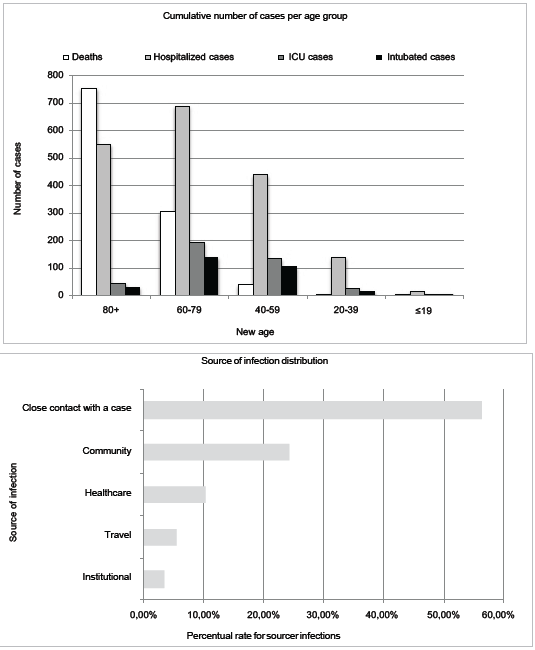
Source of infection distribution
Figure 2 Number of COVID-19 cases that ever resulted in hospitalization, intensive care unit (ICU), admission, intubation, and deaths, by age group, Toronto - January to July 2020
The severity indicator was analyzed according to the age group, considering as severity indicators: deaths, hospitalizations, intubations and hospitalization in the Intensive Care Unit (ICU). The largest number of death cases is in the age group of 80+ years with 752 cases, followed by 60-79 years, with 305 cases, and 40-59 years, with 40 cases. The lowest number of cases of death is in the age group 20-39 years and ≤19 years.
As for the number of hospitalization, the largest was found in the age group from 60 to 79 years old with 686 cases, followed by the 80+ years old with 546 cases, 40 to 59 years old with 439 cases and 20 to 39 years with 136 cases. The lowest number of hospitalization cases was in the age group ≤19 years with 13 cases.
Regarding hospitalizations in the ICU, about 194 are in the 60 to 79 age group, 135 in the 40 to 59 age group and 41 in the 80+ age group. It is observed that the lowest number of ICU admission was found in the youngest age groups of 20 to 39 years old with 23 cases and ≤19 years old with 3 cases.
There was a prevalence of cases of intubation in the age group from 60 to 79 years old with 140 cases and 40 to 59 years old with 101 cases and 80+ with 41 cases. The lowest numbers were between 20 and 39 years old (n=15) and ≤19 years old (n=1) (Figure 3).
Regarding contagion forms, 56.40% had close contact with a case, 24.23% in the community, 10.30% in health services, 5.58% while traveling and 3.49% in institutions.
Therefore, economic and financial actions, travel measures, support for Canadians abroad, public education, research and technology measures were developed, as described in Figure 4 and Figure 5.
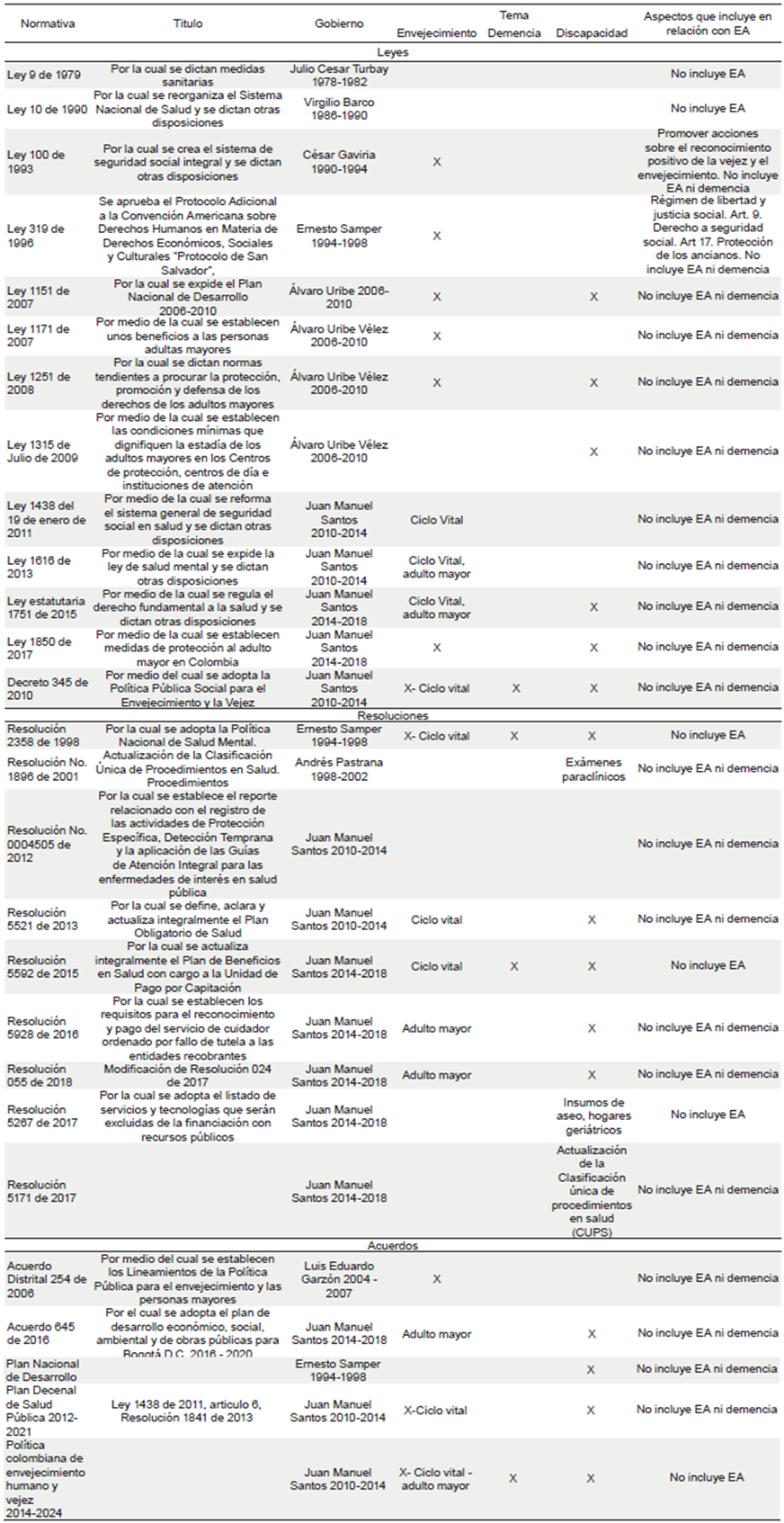
Source: Adapted from Government of Canada 7.
Figure 5 Main measures adopted by the Canadian Government to fight the COVID-19
The Canadian government, since January 2020, has monitored the outbreak of new cases of respiratory diseases originated in China and activated its operation center to guarantee an action plan (Figure 5) with preventive and control measures.
DISCUSSION
The rapid spread of COVID-19 became a worldwide public health problem, needing specialized and immediate interventions to minimize the caused impact 7,8.
The COVID 19 pandemic reached by July 1st, 2020 about 187 countries, with a total of 12,093,782 cases, the United States of America (3,067,780) and Brazil (1,713,160) being two countries with the highest number of confirmed cases of the disease, Canada appears in the 20th position presenting 108,383 confirmed cases, with 14,468 of these cases referring to the city of Toronto 9.
From these confirmed cases of COVID-19 in Toronto, women had higher rates, as well as in Wuhan, China, even though men were more likely to have serious illnesses 10.
In initial reports, younger people were less likely to be affected, although the rate continues to increase in children and adolescents over time 4,11. In this study, the lowest number of confirmed cases of COVID-19 was in the age group of less than 19 years, which corroborates with an American report with lower number of cases, hospitalizations and deaths 12). These results suggest that vigorous efforts should be made to protect vulnerable populations 13.
When analyzing the severity indicators by age group, it is noted that death, hospitalization, admission to the Intensive Care Unit and intubation, presented highest rates in the elderly population. A study carried out in China with 44,672 patients showed that the majority of cases (81%) had mild symptoms, while 14% developed severe conditions and the remaining 5% became seriously ill. Severity increased with age and the risk of fatality was higher (14.8%) in individuals aged 8o years or older with underlying chronic conditions, such as cardiovascular disease (10.5%), diabetes (7.3%) or chronic respiratory diseases (6.3%) than among individuals without pre-conditions (0.9%) 14.
Government actions implemented during the COVID-19 pandemic
The current COVID-1g epidemiological scenario forced the Canadian government to take several valuable actions to mitigate collateral damage in the economic, social, educational and health systems. Some of these actions are traffic restriction, social isolation, economic support for companies and individuals, investments in health research, and partnerships with companies for the production of Personal Protective Equipment (PPE).
Economic - financial
The economic well-being is related to population health, life expectancy, infant mortality, and maternal mortality 15, being affected in a pandemic scenario on a global scale. The current financial situation has been compared with that of World War II 16.
Studies estimate a global reduction of Gross Domestic Product (GDP) in 0.6%, where open economies will be the most affected. The main objects of study are the direct and indirect economic costs provoked by the disease and how to use mortality and morbidity information to estimate future income loss due to death and disability 15.
In Brazil, researchers are studying the impacts on small businesses in this period of crisis considering they are the first to be harmed when compared to last year, when the sector was responsible for 75% of the country's formal employability 17. The European Union, on the other hand, promised a € 1.7tn rescue package, to mitigate the economic effects of COVID-19 in the eurozone, with contributions from all member states, including the United Kingdom, and countries in the region that are not part of the European Union (Europe's economic) 16.
In the meantime, the Canadian government implemented several economic measures divided into financial and social business support, including both federal and local efforts. Some of these actions are personal financial support (individuals and families, people with disabilities, high school students and recent graduates, the elderly, indigenous people), support for companies (emergency salary subsidy up to 4 months, salary subsidy of 10%, creation of new jobs, stipulated time limit for income tax, exemption from tariffs on certain medical products), support for self-employed workers (financial incentive via CERB, reduction in tax rates related to health, an extension of the payment period for income tax) 6. Several studies 18,19 showed that the Canadian government actions helped to avoid the worst projection scenario, saving thousands of lives.
Research and technology
Since the beginning, in March 2020, the Canadian government invested in health measures with the objective of developing research on possible vaccines and treatment to respond to the COVID-1g. Canada joined other G7 countries in sharing information. Government agencies are working with the World Health Organization and the World Organization of Animal Health aiming the improvement of the global coordination, support transparent research and creation of common research platforms 20.
Many trials related to drug testing, like hydroxychloroquine, ruxolitinib, ciclesonide, anticoagulants (heparin, dalteparin and enoxaparin), actemra, lopinavir and ritonavir and vaccines are in development 21.
Canada has clinical trials in progress in phase 1 and 2 20. Countries such as Germany 22, France 23 and China 24 also have ongoing research in search of its own vaccine. The projects vary in their development and some are already forwarded for testing with volunteers.
The European Union founded the RECOVER Project (Rapid European COVID-19 Emergency Response research), where scientific entities work together through clinical research on the virus transmission and its development, in addition to studies of primary care and epidemiology related to COVID-1g 25.
In the United States, BARDA (Biomedical Advanced Research and Development Authority) maintains partner-ships with companies in the scientific progress 26, like Novavax Inc. (NVX-CoV-2373 Vaccine) and AstraZeneca (AZD1222 Vaccine) 12. In June 2020, Brazil started research and production of the vaccine against COVID-19 by Fiocruz (Fundação Oswaldo Cruz), totaling an investment of 127 million dollars 27.
In the current pandemic scenario, the articulation between scientific institutions and industries becomes indispensable for the development and supply of products and technologies to combat COVID-19. These partnerships are more common in developed countries, such as Canada. However, in Brazil, there is a difficulty in the transfer of knowledge and technologies between public universities and private companies, mainly due to the different academic and business cultures. Cultural distance is present in factors such as time horizon (research usually requires medium/long term to generate results while companies usually have the short term logic) and language of researchers and entrepreneurs 28.
Although the present countries are in different conditions and levels of research, the adopted resolutions in the scientific area in several countries against the pandemic demonstrate the worldwide concern to combat the coronavirus immediately.
Travel Measures
Borders function as a point of contact between two or more political units, where spatial, socio-cultural and economic interactions take place, through the flow of people, information and goods. However, when a disease crosses that border, a series of measures are taken by governments and institutions linked to health and sanitary surveillance 29.
In the absence of pharmacological therapies for the treatment of COVID-1g, measures were necessary to "flatten the curve", such as border stoppages, travel restrictions and quarantine in countries that constitute the largest economies in the world, causing fears of an economic crisis and impending recession 16. To contain the spread of the coronavirus, several countries in Africa, America, Asia and Europe imposed travel restrictions, as well as the closing of airports, suspension of incoming and outgoing flights and border closures 30.
The Canadian government has established emergency actions, such as the Quarantine Act, aimed at all travelers arriving in Canada, as well as travel restrictions, in order to delay the spread of COVID-19 in the country. Other countries, like China, have also restricted mobility, closing public transport networks and limiting the exit and entry of people in cities, carrying out surveillance of such measures using drones 29. Estimates demonstrate that travel restrictions could lead to a 91% reduction in the number of COVID-19 cases when implemented 31.
These measures become essential, especially regarding undocumented cases, that have been associated with a high number of the virus' transmission before travelling restrictions were adopted in China 4.
On the other hand, Sweden didn't adopt lockdown, adopting similar measures as those strategies for a "herd immunity", without social isolation and restrictions in borders, giving more attention only to the elderly and those with pre-existing comorbidities. As a result, its number of deaths in relation to the whole population was 3 times bigger than in Germany and 1072 times bigger than in Taiwan 32.
Financial assistance for Canadians abroad
The COVID-19 Emergency Loan Program for Canadians Abroad has been implemented to ensure financial assistance and help Canadians return to their origin country. According to the Canadian Health Act, the principle of portability ensures that all Canadians are covered under public health care insurance, even when travelling abroad. In countries like the United States, where the public health system does not cover the entire population and most of the healthcare is private, Canadians are exempt from hospital costs due to coverage under the Canadian Health Act 33.
Canada 33, as well as Brazil 34, Portugal 35, Argentina 36 and other countries, took measures to return their citizens to their origin country, organizing repatriation through flights chartered by the government. In most countries, these people were isolated and monitored when they arrived.
Public education
The public education's approach has the objective of implementing strategies for the dissemination of knowledge about the COVID-19, its symptoms and guidelines regarding preventive measures for the Canadian population 37. Hence, the government offers scientific-based information, mitigating the prejudicial effects of fake news and personal opinions 37.
Furthermore, the comprehension about the new coronavirus helps the population's understanding about the importance in the adoption of preventive measures, reducing their vulnerability and the virus' transmission. Different countries, such as Canada, New Zealand and Germany have used information resources, social media, newsletters and posters approaching personal hygiene strategies, such as washing hands properly, the use, production and cleaning of masks and self-isolation 37-39.
Likewise, it becomes important to emphasize the need for updates on protocols, government actions and general information for the population simultaneously with the advance of new research and outcomes of the COVID-1g. Strategies such as that of the New Zealand government with the regular promotion of press conferences and live streaming reaching more than 50 press conferences and live updates in 85 days about strategies against the new coronavirus were effective 38.
Study limitations
The data were extracted from the data information system, which brings a series of epidemiological variables and limited clinical characteristics. Therefore, individual strategies or specific variables such as the incubation period, hospitalization time, discharge time, medical treatment, among others, weren't addressed.
Canada has a strong history of pandemic planning with preventive and control actions. In conjunction with public health, it has worked for actions such as: economic, financial, travel, public education, research and technology, adaptable based on the evolution of the disease, outbreak containment and prevention of further spread ♣













